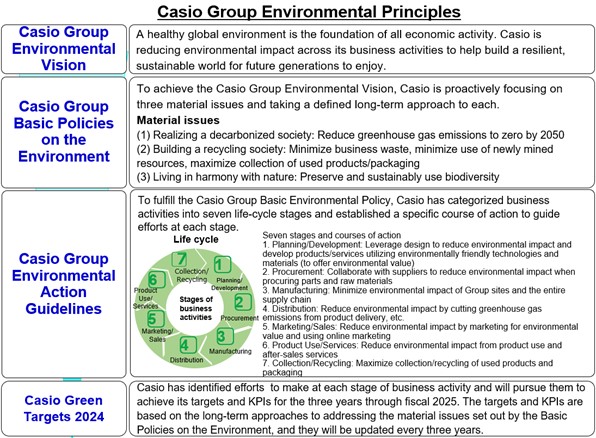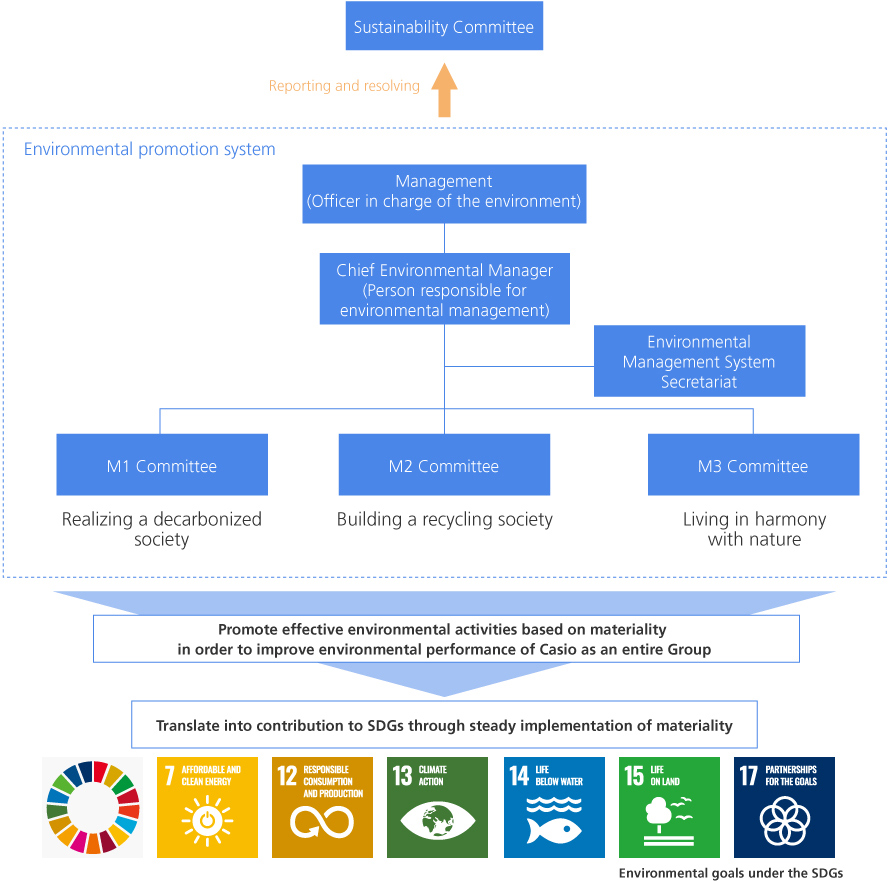Environmental Management
Vision and Basic Policies on the Environment
In 2012, Casio established the Casio Environmental Vision 2050, a long-term environmental management policy that looks ahead to the year 2050, and launched a range of initiatives. In 2021, Casio undertook a complete review of the policy to ensure that it does not fall behind the drastic and rapid changes surrounding the environment, and restructured the Casio Group Environmental Principles, which comprise the following elements.
- Casio Group Environmental Vision
- Casio Group Basic Policies on the Environment
- Casio Group Environmental Action Guidelines
- Casio Green Targets 2024
Building on the same shared principles, this restructuring unifies all of the elements, from the Casio Group Environmental Vision at the top, down to the Casio Green Targets 2024, which are targets for separate environmental initiatives taken by each organization. The restructuring also ensures that long-term policies and short-term initiatives are integrated and consistent.
Positioned just below the Vision, the Casio Group Basic Policies on the Environment establish long-term approaches for addressing the three material environmental issues of realizing a decarbonized society, building a recycling society, and living in harmony with nature. Next, the Casio Group Environmental Action Guidelines establish a course of action for each value chain from a life-cycle perspective. Finally, Casio Green Targets 2024 includes target and KPI for 3 years to be set according to the functions of each organization based on the long-term goals of key environmental issues, and will be promoted in a clear positioning.
Casio Group Environmental Principles

Implementation System
In 2016, Casio started to integrate its environmental management system into a group-wide system. First, the ISO 14001 certifications for the three main sites of Casio Computer Co., Ltd.—the headquarters, the Hamura R&D Center, and the Hachioji R&D Center—were integrated under ISO 14001:2015 certification in 2017. In addition, the company established committees to handle its three areas of material environmental goals and, as necessary, set up working groups underneath them in which committee members participate and engage in activities related to their respective areas. The system was changed to a materiality-based, top-down structure rather than the previous structure, which was based on individual departments and bottom-up. Casio will continue to manage environmental activities effectively as an entire Group using ISO 14001.
We intend to integrate each fiscal year’s efforts to achieve the Casio Green Targets 2024 into the work of these committees, a step which would dovetail ISO 14001 committee activities into the core business of each organization.

List of ISO 14001 Certified Sites
| Certified and registered site | Date acquired | Remarks | |
|---|---|---|---|
| Casio Computer Co., Ltd. | Headquarters (including seven sales sites) | December 2000 | In April 2017, Casio integrated ISO 14001 certifications for these 3 sites |
| Hamura R&D Center | October 2000 | ||
| Hachioji R&D Center | October 2000 | ||
| Yamagata Casio Co., Ltd. | Headquarters | November 1997 | |
| Casio Business Service Co., Ltd. | Headquarters | January 2000 | |
| Casio Techno Co., Ltd. | Headquarters | May 2020 | |
| Casio Human Systems Co., Ltd. | December 2001 | ||
| Casio Computer (Hong Kong) Ltd. | November 2020 | ||
| Casio (Thailand) Co., Ltd. | July 2012 | ||
| Casio Taiwan Co., Ltd. | October 2007 | ||
| Casio Electronics (Shenzhen) Co., Ltd. | February 2002 | ||
| Casio Electronic Technology (Zhongshan) Co., Ltd. | October 2006 | ||
| Casio Electronics (Shaoguan) Co., LTD. | January 2018 | ||
| Casio Timepiece (Dongguan) Co., Ltd. | September 2019 | ||
* The percentage of Group employees at sites with ISO certification has reached 76.0%.
Environmental Education
Casio provides employees with environmental education in order to promote environmental activities smoothly. In addition to general education to raise awareness and promote understanding of the environment, each committee and working group identifies the competencies required for each activity at the beginning of the fiscal year and provides specific education in accordance with an annual plan for those who need to upgrade their competency following an evaluation of the competency of each committee member.